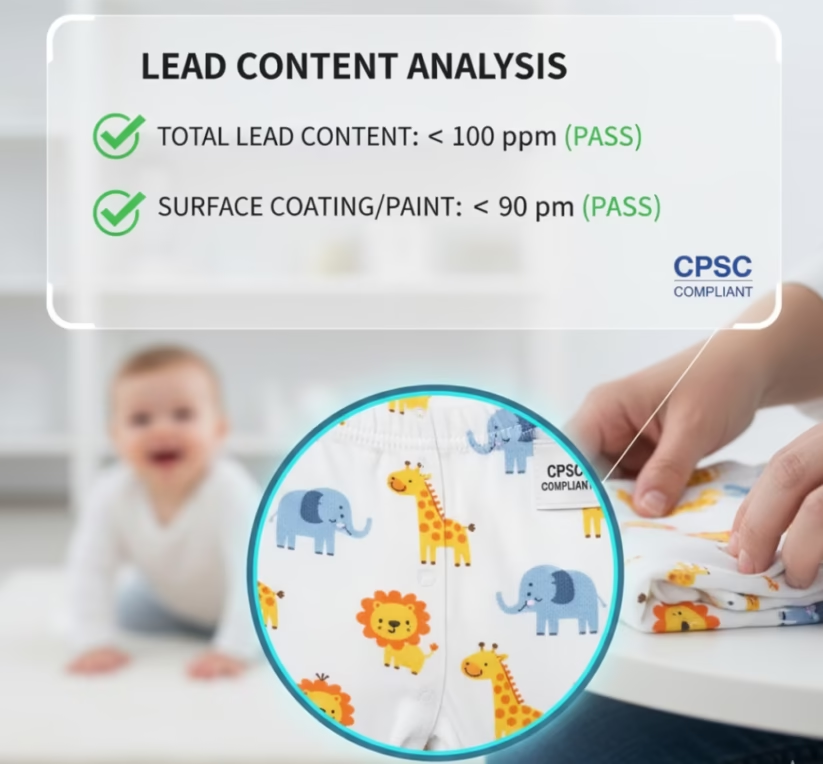How to Test Baby Clothes for Lead (Compliance Requirements)
1. The Legal Standard (Total Lead Content)
All children’s products (for ages 12 and under, which includes baby clothes) sold in the US must comply with strict limits:
-
Total Lead Content Limit: Not more than 100 parts per million (ppm) in any accessible component part of the product.2
-
Lead in Surface Coatings/Paint Limit: Not more than 90 ppm in any paint or surface coating (like screen prints, painted snaps, or zippers).3
2. The Required Testing Method: Third-Party Labs
For a baby clothing brand, you must use a CPSC-accepted, third-party accredited laboratory for compliance testing.4
-
Why Lab Testing is Required: Only a certified lab can provide the accurate, quantitative (showing the actual amount in ppm) results needed to issue a legally required compliance certificate.
-
Do-It-Yourself Kits are Insufficient: While home test kits (like LeadCheck or D-Lead) exist, they are designed for screening lead-based paint and provide only a “yes/no” or presumptive result. They are not accepted by the CPSC for children’s product compliance.
3. What Needs to Be Tested?
While plain, undyed/untreated natural textiles (like plain cotton or nonmetallic thread) are often exempted from total lead testing, any component that is colored, printed, or metal needs to be tested.
The common areas in baby clothes that must be tested are:
| Component | Why it needs testing | Limit |
| Metal Snaps, Zippers, Grommets | Metal components can contain high levels of lead. | 100 ppm Total Lead |
| Screen Prints, Heat Transfers, Logos | The inks, pigments, or plastics in surface prints are considered surface coatings. | 90 ppm Lead in Surface Coating |
| Plastic Components | Any plasticized part, like a bib lining or plastic zipper pull. | 100 ppm Total Lead |
| Non-Metallic Trim/Embellishments | Rhinestones, decorative beads, or any non-fabric attachments. | 100 ppm Total Lead |
4. The Compliance Steps for Manufacturers/Importers
If you are manufacturing or importing baby clothes, you must follow this process:
-
Select a CPSC-Accepted Lab: Find a laboratory that is accredited to perform testing for the Total Lead Content rule (15 U.S.C. § 1278a).
-
Submit Samples: Send samples of your final product, or the individual components (like snaps, zippers, and screen-printed fabric pieces), to the lab.
-
Receive Test Report: The lab will provide a formal report detailing the lead concentration in parts per million (ppm) for each component tested.
-
Issue a Children’s Product Certificate (CPC): If the results pass (i.e., meet the 100 ppm and 90 ppm limits), you must then draft and issue a Children’s Product Certificate (CPC).5 This is a legal document confirming that your product complies with all applicable safety rules.6 This certificate must accompany the shipment and be available to the CPSC upon request.7
In summary, to legally sell baby clothes in the US, you do not test them yourself with a home kit—you must rely on certified, third-party lab results.8
A propos de l'auteur
Xhiney, fondatrice de Petelulu, possède plus de 20 ans d'expérience dans la conception, la production et le commerce international de vêtements pour enfants. Elle a contribué à Vêtements pour enfants et Junior Xhiney a passé 17 ans à travailler avec des marques de vêtements pour enfants haut de gamme en Europe et aux États-Unis, apportant son expertise et son soutien.

